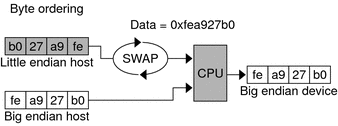Endianness
To achieve the goal of multiple-platform, multiple-instruction-set architecture portability, host bus dependencies were removed
from the drivers. The first dependency issue to be addressed was the endianness,
that is, byte ordering, of the processor. For example, the x86 processor family
is little-endian while the SPARC architecture is big-endian.
Bus architectures display the same endianness types as processors. The PCI local bus,
for example, is little-endian, the SBus is big-endian, the ISA bus is little-endian,
and so on.
To maintain portability between processors and buses, DDI-compliant drivers must be endian neutral.
Although drivers can manage their endianness by runtime checks or by preprocessor directives
like #ifdef _LITTLE_ENDIAN in the source code, long-term maintenance can be troublesome. In
some cases, the DDI framework performs the byte swapping using a software approach.
In other cases, byte swapping can be done by hardware page-level swapping as
in memory management unit (MMU) or by special machine instructions. The DDI framework
can take advantage of the hardware features to improve performance.
Figure A-1 Byte Ordering Required for Host Bus Dependency

Along with being endian-neutral, portable drivers must also be independent from data ordering
of the processor. Under most circumstances, data must be transferred in the sequence
instructed by the driver. However, sometimes data can be merged, batched, or reordered
to streamline the data transfer, as illustrated in the following figure. For example,
data merging can be applied to accelerate graphics display on frame buffers. Drivers
have the option to advise the DDI framework to use other optimal data
transfer mechanisms during the transfer.
Figure A-2 Data Ordering Host Bus Dependency

